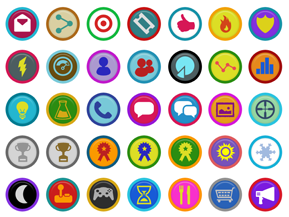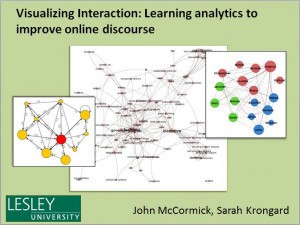 Prior to attending the event, I explored the lineup of presentations and noticed a session on the Future of Video Games. Panelists included the following: Ed Fries, architect of Microsoft’s video game business and co-founder of the Xbox project; T.L. Taylor, Associate Professor of Comparative Media Studies at MIT; Yanis Varoufakis, Economist-in-Residence at Valve Software; Christopher Weaver, founder of Bethesda Softworks and industry liaison to the MITGameLab. Games producer and Futures of Entertainment Fellow Alec Austin moderated the panel. As an educator, I was particularly interested in the ways in which technology can improve and facilitate the learning process. I was excited to hear what experts had to say about the potential commingling of games and education, but unfortunately, the panelists did not delve deeply into this topic. When confronted with a question on the trend of “gamification,” the panelists seemed to utter a collective, audible groan. Although I was disappointed that the panelists did not engage in conversation on the potential commingling of games and education, their very visceral, negative reaction to the mere term “gamification” was enlightening for me.
Prior to attending the event, I explored the lineup of presentations and noticed a session on the Future of Video Games. Panelists included the following: Ed Fries, architect of Microsoft’s video game business and co-founder of the Xbox project; T.L. Taylor, Associate Professor of Comparative Media Studies at MIT; Yanis Varoufakis, Economist-in-Residence at Valve Software; Christopher Weaver, founder of Bethesda Softworks and industry liaison to the MITGameLab. Games producer and Futures of Entertainment Fellow Alec Austin moderated the panel. As an educator, I was particularly interested in the ways in which technology can improve and facilitate the learning process. I was excited to hear what experts had to say about the potential commingling of games and education, but unfortunately, the panelists did not delve deeply into this topic. When confronted with a question on the trend of “gamification,” the panelists seemed to utter a collective, audible groan. Although I was disappointed that the panelists did not engage in conversation on the potential commingling of games and education, their very visceral, negative reaction to the mere term “gamification” was enlightening for me.
My understanding is that the rejection of “gamification” comes from the interest from a variety of fields (including education) to take a concept that is basically unfun and mask it with game-like qualities (hilarious avatars, motivational badges) to trick and seduce an audience. While I understand the desire to steer clear from the shallow and overused term “gamification,” I honestly felt a bit disheartened when the panel chose to completely dismiss the whole idea. From my perspective, there are exciting opportunities for learning and play to become intertwined, and many in the field of education use this term “gamification” to discuss this concept. Perhaps the language should change, but in order to simultaneously avoid jumping on the “gamification” bandwagon in education and still acknowledge the potential benefits of connecting learning and games, I propose educators think about the following questions….
- To what extent can educators learn from games without buying into the superficial platitudes, hype, and banalities that seem increasingly inherent in the term “gamification”?
- How can educators integrate fundamental principles of game-experiences to improve student learning in both formal and informal environments? Some of these principles/qualities could include the following:
- Ongoing, Iterative Feedback: Games provide immediate and continuous feedback loops that provide the user/player/learner with tangible ideas on how to improve their performance in future iterations. The process is ongoing, and the concept of “failure” is reconsidered….
- Rethinking “Failure”: Our culture often adheres to binary thinking – good vs. bad, right vs. wrong, success vs. failure. In order to encourage resiliency and risk-taking among learners, educators may want to rethink how “failure” and “failing” is communicated to young people. In games, failure is merely an opportunity for formative assessment that a player uses for continuous improvement
- Rewarding Creativity and Collaboration: In traditional schooling, much of what could be considered collaboration and creativity in games would be considered cheating. Educators ought to value and reward effective collaboration and expand the learning process to include the ability to creatively learn with and from one another.
- To what extent can educators capitalize upon the engaging and captivating qualities of games by integrating content from popular games into curricula for learners? How can we encourage students of all ages to reflectively examine the images, signs, and messages being communicated through popular games to foster critical thinking and thoughtful analysis?
Author James Paul Gee has written extensively on the ways in which education can learn from games. I highly recommend his book “What Video Games Have to Teach Us about Learning and Literacy.” For his ideas on learning principles that are integrated in good games, check out his paper “Good Games and Good Learning.”
Another related session during the conference was titled Curing the Shiny New Object Syndrome: Strategies Vs. Hype When Using New Technologies. The panel was comprised of the following: Todd Cunningham, Futures of Entertainment Fellow and television audience research leader; Jason Falls, CEO of Social Media Explorer; Eden Medina, Associate Professor of Informatics and Computing at Indiana University; Mansi Poddar, co-founder of Brown Paper Bag; and David Polinchock, Director of AT&T AdWorks Lab. The panel was moderated by Ben Malbon, Managing Director at the Google Creative Lab. Panelists began by defining the phrase “shiny new object” which generated the following words and phrases…
- Expensive
- Modern
- Futuristic
- Everyone is using it!
- Hyped
- Human bias toward the new
The major motivator driving the “shiny new object syndrome” was to create the appearance of being innovative and cutting edge. Another motivator included the “human bias toward the ‘new.’” However, panelists noted what is consistently missing when adopting a “shiny new object” is the reflection on goals. What are the high-level objectives driving the use of the tool/idea/program? Instead of blindly adopting and implementing these new, attractive technologies, practices, or concepts, panelists emphasized the importance of first identifying authentic goals for why and how this tool will be used. The “shiny new object syndrome” can be cured by continuous reflection on the end goal – the tool, or the means, is secondary.
Gamification could potentially fall under this category, as an exciting concept that has become quite a popular, and often empty, buzzword. The recent obsession with Massive Open Online Courses (MOOCs) could possibly be considered another example of an idea that has recently fallen victim to the “shiny new object syndrome.” The reason I use the word “possibly” is because of the importance of intent. Are MOOCs being implemented to increase access to education and facilitate deep learning experiences for all learners? Reading Larry Cuban’s recent blog post MOOCs and Hype Again reminded me of this discussion at FoE6. Cuban expresses concern about the increasing media noise surrounding MOOCs and the potential impact on the main goal – student learning.
Exciting ideas like MOOCs and “gamification” have the potential to be designed in ways that support incredibly valuable end goals, but again, we must think critically about the overarching goals and consciously avoid getting caught up in this “shiny new object syndrome.”
[Image via Graphic Design Junction]




